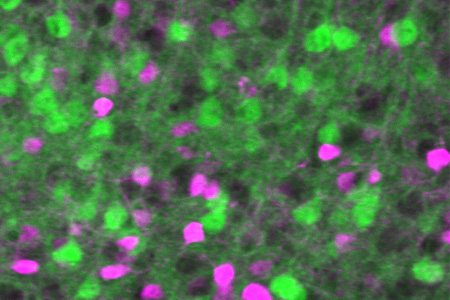Biologists Detail the Brain’s Balancing Act
August 18, 2014
By Kim McDonald

A fluorescent image shows excitatory neurons in green and inhibitory neurons in magenta.
UC San Diego School of Medicine
Biologists at UC San Diego have discovered a fundamental mechanism by which the brain maintains its internal balance. The mechanism involves the brain's most basic inner wiring and the processes that control whether a neuron relays information to other neurons or suppresses the transmission of information.
The scientists show in a paper published in the July 31 issue of Nature, that there is a constant ratio between the total amount of pro-firing stimulation that a neuron receives from the hundreds or thousands of excitatory neurons that feed into it, and the total amount of red-light stop signaling that it receives from the equally numerous inhibitory neurons.
This constant ratio, called the E/I ration, was known to exist for individual neurons at a given time. This study goes a step further and shows that the E/I ratio is constant across multiple neurons in the cortex of mice and likely also humans, since the fundamental architecture of mammalian brains is highly conserved across species.
“Neurons in our brain drive by pushing the brake and the accelerator at the same time,” said Massimo Scanziani, a professor of neurosciences and neurobiology and a Howard Hughes Medical Institute investigator, who is a co-author of the paper. “This means that there is no stimulus that you can apply that will activate purely excitatory neurons or purely inhibitory ones.”
Read more in the UC San Diego News Center release.
